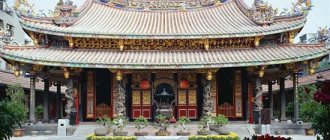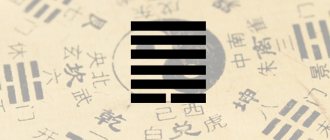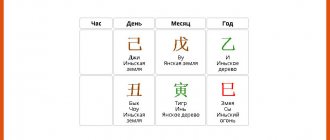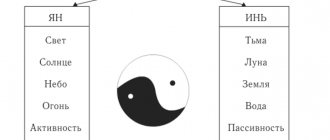Yin is impossible without Yang, Yang is impossible without Yin. This is a connection between body and mind, a union of complementary forces and energies, feminine and masculine. It is a balance between good and evil. This is the understanding that in everything good there is something bad, and in everything bad there is something good. This is the ideology of life, culture and religion.
Heaven and earth, day and night, ebb and flow... Have you noticed that there are many things that depend on each other for their existence? This is the Yin-Yang principle. Chinese philosophy says exactly this: there are always two opposing forces that are in harmony with each other.
The principle of Yin and Yang is found in the Chinese “Book of Changes” (I Ching). The main religious or philosophical context is Taoism, and although this may all seem a little strange, the basic idea is very simple: all things have a necessary polar opposite.
According to the Yin-Yang philosophy, two opposing forces always alternate: a high phase is followed by a low phase, movement is followed by rest, and so on. You've probably already experienced this in your daily life. After all, some days you feel better, and other days you have little energy and are in a bad mood.
Yin and Yang, what does this symbol mean?
What are Yin and Yang? These are two opposite principles in nature, Yin阴means feminine and negative, Yang阳means masculine and positive.
Yin and Yang theory holds that everything in the universe has opposing and united aspects of Yin and Yang, constantly moving and interacting. This type of movement and interaction is the root of all movement and change.
The most primitive point of the Yin and Yang theory is to find the laws of nature in the world and make people obey these laws. The simplest way to reflect the change of Yin and Yang in nature is day and night. The change of day and night is regular, every day is the same. The Chinese call the place where there is sun exposure - Yang, and the place not exposed to the sun (there was shadow) - Yin.
The ancients classified everything according to Yin and Yang, for example:
Yang : sun, light, sky, activity, time, east, south, left, ...
Yin : moon, shadow, earth, peace, space, west, north, right, ...
From the above words, we can see that there are more positive words that belong to Yang, and more negative words that belong to Yin, although this is a natural phenomenon. The Chinese worship Yang more and oppose Yin, as people who adore the sky and the sun more than the earth and the moon.
Symbolism of Yin-Yang:
There is a basic relationship between Yin and Yang. And they consist of 4 main aspects:
- Yin and Yang are opposites.
Yin and Yang are essentially opposites and contradict each other. Things have Yin and Yang attributes, so things with different Yin and Yang attributes are also opposite.
- Yin and Yang interact.
There is interdependence and interaction between Yin and Yang.
- There is a balance between Yin and Yang.
Everything is in absolute motion. Yin and Yang in the Universe are constantly changing.
- There is a mutual transformation between Yin and Yang.
Under certain conditions, Yin and Yang transform into each other.
A woman has too much yang energy
1. Male physique. Large shoulders, narrow hips, dry muscles - this type of figure is often caused by an excess of Yang energy in a woman. And if such a woman begins to gain weight, then this happens, as a rule, according to the male type: her arms in the shoulder area become fuller and her stomach grows.
2. The habit of “building everyone up.” A woman with an excess of Yang energy loves to command and does not tolerate disagreement with her opinion.
3. Tension. Yang is the energy of constant tension. It is very difficult for a woman who is dominated by this energy to relax and “turn off her brain.”
4. Inability to accept. Yang energy is a giving energy, not a receiving one. It is not surprising that a woman with an excess of this energy is ready to give away her “last shirt.”
5. Sexual deviations. The desire for rough sex with elements of violence is a way for women with energy imbalances to harmonize themselves.
Basic concepts defining the nature of Yin and Yang
The two halves (male and female) form a single whole - this is the sign of Yin and Yang, therefore it is a circle divided into two tear shapes of opposite colors: black and white. The right side, black, goes down and the left, white, goes up, creating a clockwise movement pattern. Since the circle is a whole, the two halves cannot be complete without each other.
Colors:
- White - symbolizes enlightenment.
- Black - symbolizes its direct opposite or deception.
Ancient Chinese philosophers and scientists understood that the world is in a constant state of change, but that it moves through different frames of cycles, each of which has opposite and equal value:
- day and night;
- cold and warmth;
- birth and death;
- Sun and moon.
By exploring this world of constant cycles, the rules of life became apparent and confirmed the theory that opposites must exist to create a whole. Yin (black) is considered the essence of feminine energy, and Yang (white) is considered masculine.
The Yin-Yang of life becomes the last divine circle:
- Night becomes day and day becomes night again.
- Birth ends in death and death ends in rebirth.
Both halves of the symbol are curved and this creates a sense of movement as the halves taper into a tail effect. Yang, the left side, is white, and Yin, the right side, is black. This represents the opposing qualities of the two energies.
It's important to note that inside each curved half there is another very small circle. This small inner circle is the opposite color and corresponds to the opposite half. The small dot symbolizes how each side depends on the other for its existence.
The smaller circle also represents the transformation brought about by coexistence and dependence on each other. This is a wonderful sign to show how everything is connected and nothing in life is lonely. Every person, animal, plant, element, etc. depends on others for their existence. Nothing can exist on its own.
The Yin-Yang sign is a symbol of integrity. This unity and union is created by the other half of matter, which is the opposite half. This is the law of nature and the only way that any individual being or element can achieve wholeness.
Unity is the promise of the circle. Yin must have Yang, and Yang must have Yin, otherwise there can be no life. There can be no balance.
In Taoism, this circle represents the most basic elemental energies of women and men, which are the energies of all creation.
It is easy to get confused as to which of the two symbols is Yin and which is Yang. Equally difficult is remembering the elements that accompany each one.
It's easy to remember that Yin means the dark side. The shaded side of the mountain always faces north. The shaded side is dark and corresponds to the black side of the Yin-Yang symbol.
Energy Type Test
We invite you to take a test to determine the type of energy:
- Can you say with confidence that your hands and feet are almost always warm (yes - “+8” points, no - “-8”)?
- Would you prefer hot summer to winter (yes – “+4”, no – “0”)?
- Do you like winter more than summer (yes – “-4”, no – “0”)?
- Are you overweight (yes – “+1”, no – “0”)?
- Are you of normal weight or below normal weight (yes – “-1”, no – “0”)?
- Do you consider yourself an energetic person (yes – “+8”, no – “0”)?
- Does physical labor tire you (yes – “0”, no – “+4”)?
- Do you consider yourself a lazy person (yes – “-4”, no – “+4”)?
- Are you able to fall asleep in a car (yes – “-8”, no – “+8”)?
- Are you sexually active (yes – “+8”, no – “-8”)?
- Do you have a beautiful, toned figure (yes – “+4”, no – “-4”)?
Now calculate the result:
- A minus indicates that Yin energy predominates in you.
- If you get 1-8 points, you are a representative of Yang energy.
If, based on the test results, you see that Yang energy is literally boiling in you, diversify your diet with Yin food: eat more cereals, vegetables, seafood and fish, and also exclude too fatty, salty and sweet foods from your diet.
Yin people are recommended to include meat, dairy products, sweets in their diet, and you can also experiment with spices.
Yin and Yang origin
Yin and Yang are an ancient philosophy of China and the central element of logical thinking in Chinese civilization. This is a description of the fundamental factors underlying the laws of nature that contributed to its development and changes in ancient China.
Ancient Chinese thinkers believed that everything in the universe consists of two mutually opposing and interdependent aspects. These two aspects are called Yin and Yang. Today, the Yin-Yang theory continues to influence the current lives of the Chinese in many aspects such as the use of colors, love, medicine, architecture, etc.
The Yin-Yang symbol is called a Taijitu or Tai Chi diagram. It represents the philosophy and principles of positive and negative or opposing energies such as masculine and feminine. The word taijitu means diagram of the highest limit.
The origin of the Yin and Yang symbol is controversial, but many believe that it comes from the second “phrase” (calligraphy) of the I Ching called “Book of Changes.” The book places the sun at the top and the moon at the bottom. The modern symbol is a stylized interpretation of this character.
It is interesting to note that this symbol appears on Roman shields. The badge was used to indicate which region the army was assigned to, so it became a regional badge.
There is no historical evidence to indicate any connection between the Romans' use of this symbol and the Chinese use of the Yin-Yang symbol.
Another stylized symbol on the Roman shield was three circles, one inside the other and cut in half. The outer circle on one side was a dark shade, and its opposite side was a lighter shade. The next half of the circle was light, the opposite half was dark, and so on.
- 3rd century Celtic art depicts a similar symbol, which is not always shown in opposing colors.
- The South Korean flag has a two-color Yin-Yang symbol and is depicted with halves on top of each other rather than side by side.
Yin and Yang of spirit and soul
Yin-Yang in Taoist philosophy is a symbol of the connection between body and mind and, on the other hand, a symbol that connects a person with the entire universe.
These two concepts also communicate that we are energy with two forces, one physical and the other spiritual, but both united in one body.
The symbol fully represents the force that pushes all phenomena from maximum points to minimum points and vice versa, and is the impetus for change and evolution.
The most important thing to remember, and the hardest thing to understand, is that everything, every phenomenon, contains both aspects of this duality, just in different degrees of manifestation.
These concepts have been revealed to be very useful for better explaining and understanding how certain phenomena work, but they are also widely used in many disciplines to study the functioning of our body.
Just as Yin and Yang are inseparable, so are the soul and body. When we talk about Yin-Yang and the body, it is important to distinguish between two types of holistic approach: one refers to position, and the second refers to type and function.
In the first case we find:
- Yang : back, outer limbs, supra-umbilical, posterolateral, organ functions, protective energy.
- Yin : chest, inner limbs, subsections, inner medial part, organ structure, nutritional energy.
Thus, the position can already indicate the relationship of one part of our body with another in a fairly simple and intuitive way.
Another method used relates to the organs and viscera: the former are considered Yin and the latter Yang.
Organs and internal organs differ from each other in the functions they perform (Yang), which, as such, ultimately influence the structure itself (Yin).
- Yin: liver, heart, pericardium, spleen-pancreas, lungs, kidneys.
- Yang: Gall Bladder, Small Intestine, Triple Warmer, Stomach, Large Intestine, Bladder.
The forces of Yin and Yang in everyday life
The relationship between the two forces is also practiced in Traditional Chinese Medicine. Here organs are divided into active and passive functions. Yin, for example, corresponds to the heart, liver and lungs, while Yang is found in the stomach, intestines and bladder. Therefore, in traditional Chinese medicine, the activities of individual organs are coordinated in the best possible way.
Therefore, Yin and Yang are much more than a small symbolic sign and can be found around us every day. After all, contrasts are everywhere.
And a few words about flowers.
The symbol that immediately comes to mind when we think of Yin-Yang is made up of white and black parts. The black zone (Yin) represents darkness, calm, passive perception, feminine and soft. On the other hand, the color white (Yang) symbolizes the sun or radiance and warmth, active dedication and masculinity.
Moreover, you will also find this difference in yoga: Yin yoga consists mainly of rest and breaks. Therefore, all movement-oriented variations such as Hatha Yoga or Bikram Yoga are considered a type of Yang Yoga.
Talismans Yin and Yang
In the Western world, Yin and Yang have become popular in Feng Shui, which means wind and water in Chinese. In its original sense, Feng Shui is an idea of Taoism and refers to the harmony that should exist in space, specifically the harmony between Yin and Yang.
This Taoist philosophical principle has been adapted by Western mentality to seek balance in the distribution of the home (furniture distributed in a certain way and according to the orientation of the cardinal directions).
The Yin-Yang symbol also has a decorative dimension and application, as it is a very common design in the world of tattoos, jewelry and decorative elements.
Finally, it must be remembered that Yin and Yang have certain similarities with some Western philosophical approaches (the struggle of opposites of Heraclitus or the concept of dialectics of philosophers such as Plato or Marx).
The Yin-Yang symbol indicates the balance of forces. Simply put, we can say that in everything good there is something bad, and in everything bad there is some good. In this sense, Yin-Yang resembles the idea of balance between opposites, since for one thing (for example, light) to exist, there must be an opposite (darkness).
The energies of Yin and Yang show that life is an illusion because things are often not what they seem. In fact, situations and people are often the opposite of what we believe or assume.
Natalia Shakhova
Yin-Yang tattoo: options for a successful location on the body
A round Yin-Yang tattoo does not always look good on the calf, wrist or back. Tattoo artists recommend depicting the sign of life on the chest, neck, shoulder blade, shoulder or forearm. Watercolor style options will look great on the foot and ankle. People who are associated with Eastern culture often focus on the energy centers of the human body. It is believed that a Yin-Yang tattoo on the neck symbolizes harmony between words and thoughts, honesty and truthfulness. A tattoo depicted on the chest will allow you to liberate yourself emotionally. Girls like to have designs on their wrists, while men prefer tattoos on their shoulder blades or shoulders.







